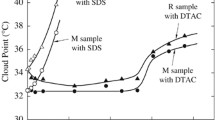Abstract
The amphiphilic nature of 3, 6-bisdimethylaminoacridine (trivial name, acridine orange) can be used to characterize (polar/nonpolar) interfaces. This paper studies the properties of acridine orange and its dodecyl derivative at a solvent interface by internal reflection and tension determinations. In the case of absorbance measurements of crystallized acridine orange, the potenz value of the conventional acid dissociation constant pK a was found to be 9.6. A clear isosbestic point could be obtained after purification at a unique pH for different concentrations. In contrast, in the absorbance measurements of acridine orange dodecyl, no isosbestic point was observed; this was attributed to the free long dodecyl chain. The overlap in the absorbance spectrum and the normalized fluorescence spectrum was found in many solvents around 500 nm. Neutral species were more likely to transfer into organic phase upon shaking. For fluorescence measurements both steady-state and time-resolved spectra were investigated. Results showed that at the interface a bathochromic shift happened to the maxima. This means that chromophore species aggregated at the interface as the dimer or trimer or the macro oligomer. Fluorescence polarization in bulk was calculated and found to be ca. 0.4. For interfacial measurements a dynamic volume method was applied to obtain the interfacial tension. An extrapolated Gibbs plot was obtained. Increasing bulk concentration increased the concentration at the interface to a finite value representing saturation.
Similar content being viewed by others
REFERENCES
J. D. Burbage and M. J. Wirth (1992) J. Phys. Chem. 96, 5943–5948. (b) J. D. Burbage and M. J. Wirth (1992) J. Phys. Chem. 96, 9022–9025.
D. A. Piasecki and M. J. Wirth (1993) J. Phys. Chem. 97, 7700–7705.
J. M. Kovaleski and M. J. Wirth (1995) J. Phys. Chem. 99, 4091–4095.
J. C. Conboy, J. L. Daschbach, and G. L. Richmond (1994) J. Phys. Chem. 98, 9688–9692.
A. Vincze, G. Horavai, and F. A. M. Leermakers (1995) Electrochim. Acta 40, 2875–2879.
J. Stecki and S. Toxvaerd (1995) J. Chem. Phys. 103, 4352–4359.
B. C. Burdet (1983) in E. Wyn-Jones and J. Gormally (Eds.), Studies in Physical and Theoritical Chemistry, Aggregation Processes in Solution, Vol. 26, Elsevier, Amsterdam, pp. 260, 276, 278.
D. B. Davies, L. N. Djimant, and A. N. Veselkov (1996) J. Chem. Soc. Faraday Trans. 92, 383–390, and references therein.
B. H. Robinson, A. Löffler, and G. Schwarz (1973) J. Chem. Soc. Faraday Trans. 1 69, 56–69.
B. H. Robinson, A. Seelig-Löffler, and G. Schwarz (1975) J. Chem. Soc. Faraday Trans. 1 71, 815–830.
G. R. Haugen and W. H. Melhuish (1964) Trans. Faraday Soc. 60, 386–394.
X. He, X. Feng, G. Zhange, and H. Shi (1995) Fenxi Huaxue, i.e., Chin. J. Anal. Chem. 22(6), 565–568 (in Chinese with an English abstract).
M. Wong, J. K. Thomas, and T. Nowak (1977) J. Am. Chem. Soc. 99, 4730–4735.
M. Hamed, E. Abdalla, and M. Mahmoud (1994) Can. J. Appl. Spectrosc. 39, 126–131.
G. D. Correll, R. N. Cheser III, F. Nome, and J. H. Fendler (1978) J. Am. Chem. Soc. 100, 1254–1262.
Z. Samec, V. Marecek, and D. Homolka (1981) J. Electroanal. Chem. Interfac. Electrochem. 126, 121–129.
R. Acheson (1973) Acridines, 2nd ed., Interscience, New York. (b) E. Rood (1957) Chemistry of Carbon Compounds, IV(A), Elsevier, Amsterdam, p. 671.
J. Schreiber and M. P. Daune (1974) J. Mol. Biol. 83, 487–501.
For more details on interfaces see (a) B. G. Cox (1994) Modern Liquid Phase Kinetics, Zeneca, Oxford; (b) C. Gutierrez and C. Melendres (1990) Spectroscopic and Diffraction Techniques in Interfacial Electrochemistry, NATO Advanced Science Institute Series C, Vol. 320, Kluwer Academic, Dordrecht; (c) B. Derjaguin (1987) in J. Kitchener (Ed.), Surface Forces, Plenum, New York.
Author information
Authors and Affiliations
Rights and permissions
About this article
Cite this article
Murad, M.M. Fluorescence Analysis of Acridine Orange Adsorbate at the Water/N-Heptane Interface, Bulk and Interface. Journal of Fluorescence 9, 257–263 (1999). https://doi.org/10.1023/A:1022567919705
Issue Date:
DOI: https://doi.org/10.1023/A:1022567919705



